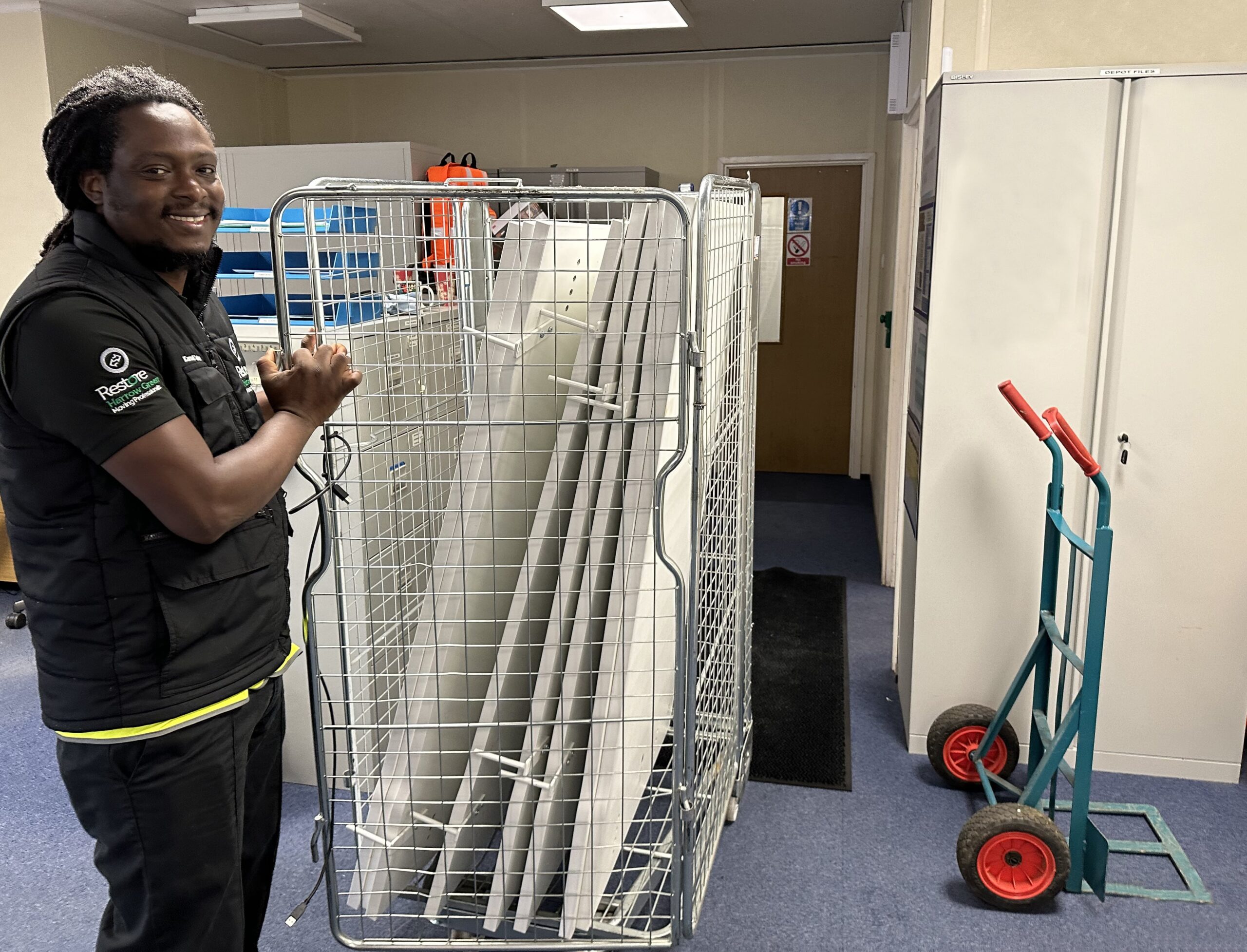Relocating an office is a significant undertaking that demands meticulous planning, seamless coordination, and efficient execution. Whether your business is expanding into a larger space, downsizing to optimise costs, or relocating to a different city, a well-structured approach will minimise disruption to daily operations. The complexities of an office move, from IT infrastructure and furniture logistics to employee transitions, require expert guidance to streamline the process.
With over 40 years of experience in business relocations, Restore Harrow Green specialises in tailored solutions that guarantee a smooth and stress-free move. Our team of professionals understands the intricacies involved in business relocations and is committed to handling every aspect with the utmost precision and care.
This comprehensive office move checklist will guide you through each stage of the process, from initial planning to post-move adjustments. Managing a small office move? Orchestrating a large-scale corporate relocation? This guide will make sure your transition is executed efficiently.
Let’s get started on making your office move as flawless as possible.
Why Every Business Needs an Office Relocation Plan
A well-structured office relocation plan is essential for keeping your move organised, on schedule, and within budget. Without a clear roadmap in place, it becomes far too easy for deadlines to slip, equipment to be misplaced, or productivity to dip during the transition. A comprehensive plan will keep every department aligned, highlight dependencies, and prevent last-minute surprises.
A clear relocation checklist also helps you identify potential risks early – whether that’s IT downtime, compliance considerations, or specialist handling for sensitive equipment – and allows you to allocate the right resources ahead of time. By approaching your move with a practical, well-communicated plan and ideally a relocation partner, businesses can maintain continuity and support their teams through a smoother, more efficient relocation.
Phase 1: Initial Planning (6–12 Months Before Moving)
1. Establish a Relocation Committee

A successful office move requires a dedicated team overseeing the process. Assign key personnel from IT, HR, and operations to form a relocation committee. Define their roles and responsibilities for clear communication and collaboration throughout the move.
Your relocation committee should include representatives from different departments to cover all operational aspects. Key roles may include:
- Project Manager: Runs the entire moving process so that timelines are met.
- IT Lead: Manages data migration, equipment relocation, and network setup.
- Facilities Manager: Coordinates space planning and furniture logistics.
- HR Representative: Covers employee communication and well-being during the move.
- Finance Manager: Oversees budgeting, vendor contracts, and cost control.

Each committee member should have well-defined responsibilities to ensure clarity and prevent misunderstandings. Some essential tasks include:
- Developing a detailed office move plan.
- Working with external vendors, movers, and real estate agents.
- Minimising disruption to employees and business operations.
- Establishing a timeline for key milestones.
- Addressing employee concerns and providing clear communication.

Frequent check-ins will certify that progress remains on track. Schedule biweekly or monthly meetings to:
- Review project status and address challenges
- Adjust strategies based on unforeseen circumstances
- Keep all team members aligned and updated
By forming a well-structured relocation committee, your business can effectively navigate the complexities of an office move while making the transition easy for employees and operations.
2. Set a Budget and Timeline

A well-defined budget and timeline are critical to a successful office relocation. Without proper financial planning, unexpected costs can cause delays and operational disruptions. Creating a structured budget will help allocate resources efficiently, while a clear timeline makes sure that each phase of the move is completed on schedule.
Your budget should cover all major expenses, including:
- Moving Services: Hiring professional movers, packing services, and transportation costs.
- New Office Setup: Furniture, décor, signage, IT infrastructure, and equipment.
- Lease and Legal Fees: Deposits, contract modifications, and compliance requirements.
- Technology and Security: Internet setup, server migration, access control, and cybersecurity measures.
- Contingency Fund: A buffer for unforeseen expenses such as delays, additional storage, or last-minute purchases.
To maintain financial control, review quotes from multiple vendors, negotiate contracts, and track spending through a detailed expense report.

Establishing a timeline is crucial to preventing last-minute rushes and business disruptions. A structured timeline should include:
- 6–12 Months Before Moving: Lease negotiations, relocation planning, and stakeholder communications.
- 3–6 Months Before Moving: Hiring movers, finalising layouts and updating business services.
- 1–2 Months Before Moving: Packing, IT infrastructure setup and employee transition plans.
- Moving Week: Supervised relocation, final IT checks, and office setup.
- Post-Move (1–4 Weeks After Moving): Troubleshooting issues, employee orientation, and post-move evaluations.
Regularly reviewing progress against your timeline helps the team meet all critical milestones without unnecessary delays
3. Conduct a Needs Assessment

Conducting a thorough needs assessment before moving in means your new office space supports your business’s operational needs and growth. A well-executed needs assessment helps avoid unnecessary costs and inefficiencies, allowing you to design a layout and plan that maximises productivity and aligns with your business goals.
The first priority is to evaluate the size and layout of the new office. Consider the number of employees, the nature of your work, and how much collaborative space you need. Will you require more meeting rooms, open-plan areas, or quiet zones? Planning this ahead of time will mean that the office space is optimised for your team’s specific needs.
- Employee workstations: Assess whether the existing desks and chairs can fit into the new space or if new office furniture is needed.
- Collaborative spaces: Evaluate areas for brainstorming, team meetings, and client discussions. Will these spaces encourage creativity and collaboration?
- Private offices: Consider the needs of your management team or any departments requiring privacy.

Your IT setup is the backbone of your business operations, so your new space must have the necessary infrastructure in place:
- Internet connectivity: Check the availability of high-speed internet in the new location and whether it meets your bandwidth needs.
- Server room: Does your new office have space for servers and the necessary power and cooling systems to keep your IT systems running smoothly?
- Phone lines and telecommunications: All communication lines are to be planned and integrated into your move, including phone systems and VOIP solutions.

Take stock of your current furniture and assess whether it will be suitable for the new office space. Sometimes, relocating provides an opportunity to upgrade your fixed or permanent fittings (e.g. lighting, cupboards and integrated tech) to better support employee comfort and productivity.
- Ergonomic solutions: Could your team benefit from a comprehensive ergonomic workspace redesign that includes task-specific equipment and wellness-focused features to reduce strain and improve workflow?
- Storage options: Identify the need for additional storage solutions to maintain an organised, clutter-free workspace.

Assess the storage needs in the new office. This includes physical storage for documents, supplies, and inventory, as well as digital storage for files and data.
- Physical storage: Will you need additional cabinets or shelving for records, office supplies, or archives?
- Digital storage: Make sure you have sufficient cloud storage and backup systems for sensitive data.
By conducting a detailed needs assessment, you can see to it that the new office space is not only functional but also scalable, offering the resources and layout required to support your team’s growth and productivity./
4. Notify Key Stakeholders

Clear and early communication is essential when relocating your office. Notifying key stakeholders well in advance means that everyone involved is prepared and aligned, helping to reduce potential disruptions and ensure a smooth transition.
Your team should be the first to know about the move. Provide them with as much notice as possible to help them prepare mentally and logistically. This may include:
- Moving dates and office layout details
- Changes in working arrangements or flexible hours during the transition
- Any adjustments to roles or responsibilities due to the move
Regular updates and an open line of communication are needed to keep morale high and reduce uncertainty.

Inform your clients of the move ahead of time, particularly if it affects service delivery or client meetings. Clear communication reassures them that your business remains stable and that their needs will continue to be met.
- Share your new office address and any changes to contact details.
- If necessary, update the location for meetings, deliveries, or services.

Reach out to your vendors and service providers to inform them of the relocation. This includes:
- IT service providers for necessary setups and transitions
- Office cleaning, maintenance, or security services
- Utility providers for changes to your address and other service details
Confirm service timelines, particularly with important services like power, internet, and phone lines. Proactively notifying key stakeholders not only builds trust, but it also minimises potential disruptions so that the move proceeds without a hitch.
Security and Confidentiality
During the move, sensitive documents and equipment need to be securely transported. Make sure the services include secure document storage and guarantee all your assets are handled with the utmost care and confidentiality.

Comprehensive Service
From packing and unpacking to post-move support, Restore Harrow Green provides a full range of services tailored to your business’s needs. The attention to detail means that everything from your office furniture to the smallest items is safely relocated and properly set up.

Phase 2: Preparing for the Move (3–6 Months Before Moving)

Develop a structured office move to-do list, covering:
- Inventory and asset management
- IT infrastructure and data backup
- Employee moving logistics
- Security considerations

A critical component of any IT office move checklist, this step involves:
- Transferring phone lines, internet services, and servers
- Conducting a cybersecurity risk assessment

Coordinate with service providers to update your address for utilities, insurance, and subscriptions. Arrange for office cleaning services at both the old and new locations.

Help staff adapt by providing relocation guides, organising Q&A sessions, and assigning moving coordinators. Consider flexible working arrangements during the move to reduce operational downtime.

Unforeseen issues can arise, so create backup strategies for power outages, internet outages, or delays in furniture delivery.
Phase 3: Moving Week (1–2 Weeks Before Moving)

Implement a structured labelling system for:
- Employee workstations
- IT equipment and cables
- Important files and confidential documents

Make sure all data backups are complete, test network connectivity at the new office, and confirm server room readiness.

Send a final reminder to employees and clients about the move date, new office address, and key contact information.
Phase 4: Moving Day

Assign team members to supervise loading and unloading at both locations. IT professionals should be present to assist with the technical setup.

Check for:
- Any remaining items or confidential documents
- Damage to the property that requires repairs
- Utility disconnections

Workstations, Wi-Fi, and telecommunication systems should be operational. Distribute employee desk assignments according to the floor plan.
Phase 5: Post-Move Adjustments (1–4 Weeks After Moving)

Address any connectivity problems, install additional security measures, and refine workstation layouts based on employee feedback.

Acclimate employees to the new workspace with a guided tour, updated emergency procedures, and perhaps even a welcome event to boost morale.

Gather feedback from employees and stakeholders on the relocation process. Identify areas for improvement for future moves.

Update your company’s new address on your website, social media, Google My Business, and other online directories.
Additional Considerations for Business Relocation
Secure Office Storage Solutions
If you require temporary or long-term storage, Restore Harrow Green offers secure office storage facilities across the UK with 24-hour CCTV monitoring.

Minimising Disruption to Business Operations
Schedule the move outside peak business hours, implement remote working options for employees and use staggered moving schedules to reduce downtime.

Sustainability in Office Moves
Reduce waste by donating unwanted furniture, recycling old IT equipment, and using eco-friendly packing materials.


The Importance of Professional Business Relocation Services
Handling a move internally can be overwhelming. Restore Harrow Green provides comprehensive relocation solutions, ensuring efficiency and minimal disruption.
A successful office move requires careful planning, coordination, and execution. By following this office move checklist, businesses can expect to experience a seamless transition with minimal downtime. Whether relocating within the UK or internationally, Restore Harrow Green’s expert business relocation services make the process smooth, stress-free, and efficient.
For more information or to get started on your relocation journey, contact Restore Harrow Green or request a quote today.
 Customer Login
Customer Login